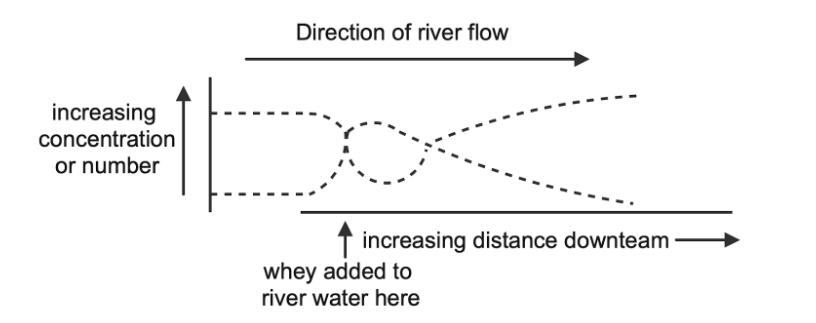
The diagram below shows the effect of polluting a river with untreated whey. What does graph X represent?

A. Bacterial count
B. Number of fish
C. Mass of curds
D. Concentration of rennet

Answer
319.8k+ views
Hint: Before we proceed into the problem, it is important to know the definition of whey. Because of the high concentration of minerals (0.7-0.8%) in whey, their economic use is limited in many applications. Due to their high mineral content, many whey-based products have a salty flavor, which is a significant drawback. To create dry demineralized whey for specialized purposes, whey is demineralized.
Step by step solution:
Whey is a by- or co-product of the dairy industry that is produced in vast quantities and has significant environmental issues because of its high organic matter concentration.

The majority of coliform bacteria enter streams or rivers directly through waste deposition in the water and runoff from areas with high animal densities. Animals kept as pets are a major source of bacterial pollution.
Since the BOD is fluctuating in graph X, bacteria or other oxidizing microorganisms are required to oxidize the organic matter.
Therefore, graph X represents bacterial count.
So, option A is correct.
Note: The high biochemical oxygen demand (BOD5) of whey creates a significant global disposal and pollution issue for the dairy sector, which urgently requires an effective and long-lasting solution. In accordance with federal environmental standards, biological waste water treatment technologies can help with the safe disposal of whey or whey permeates.
Step by step solution:
Whey is a by- or co-product of the dairy industry that is produced in vast quantities and has significant environmental issues because of its high organic matter concentration.

The majority of coliform bacteria enter streams or rivers directly through waste deposition in the water and runoff from areas with high animal densities. Animals kept as pets are a major source of bacterial pollution.
Since the BOD is fluctuating in graph X, bacteria or other oxidizing microorganisms are required to oxidize the organic matter.
Therefore, graph X represents bacterial count.
So, option A is correct.
Note: The high biochemical oxygen demand (BOD5) of whey creates a significant global disposal and pollution issue for the dairy sector, which urgently requires an effective and long-lasting solution. In accordance with federal environmental standards, biological waste water treatment technologies can help with the safe disposal of whey or whey permeates.
Recently Updated Pages
Given diagram showing a typical agarose gel electrophoresis class 13 biology NEET_UG

Capping is a process in which A adenylate is added class 12 biology NEET_UG

Explain in brief the separation and isolation of DNA class 12 biology NEET_UG

Number of testicular lobules in testes is A 250 B 500 class 12 biology NEET_UG

Master Class 12 Business Studies: Engaging Questions & Answers for Success

Master Class 12 Economics: Engaging Questions & Answers for Success

Trending doubts
What is BLO What is the full form of BLO class 8 social science CBSE

Which places in India experience sunrise first and class 9 social science CBSE

Differentiate between an exothermic and an endothermic class 11 chemistry CBSE

The shortest day of the year in India

What are the major means of transport Explain each class 12 social science CBSE

Which are the Top 10 Largest Countries of the World?




